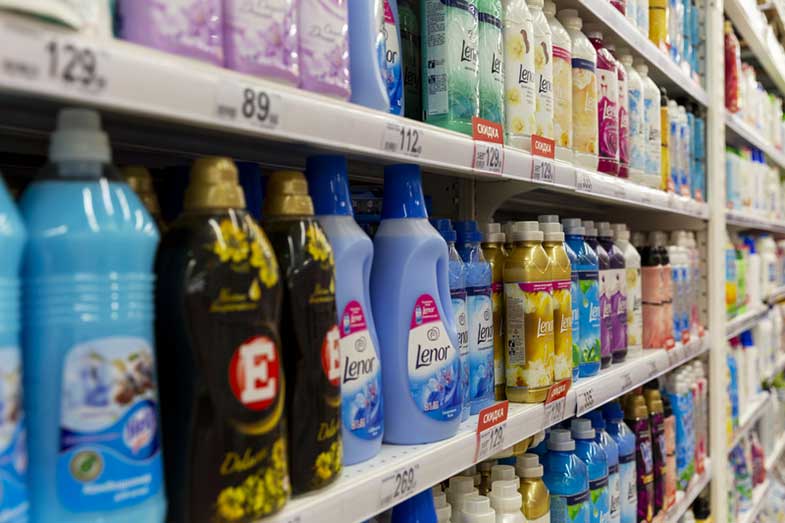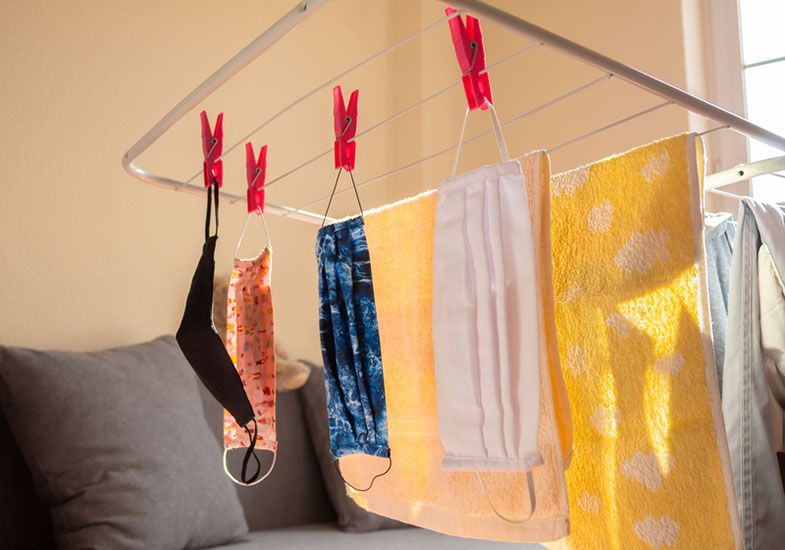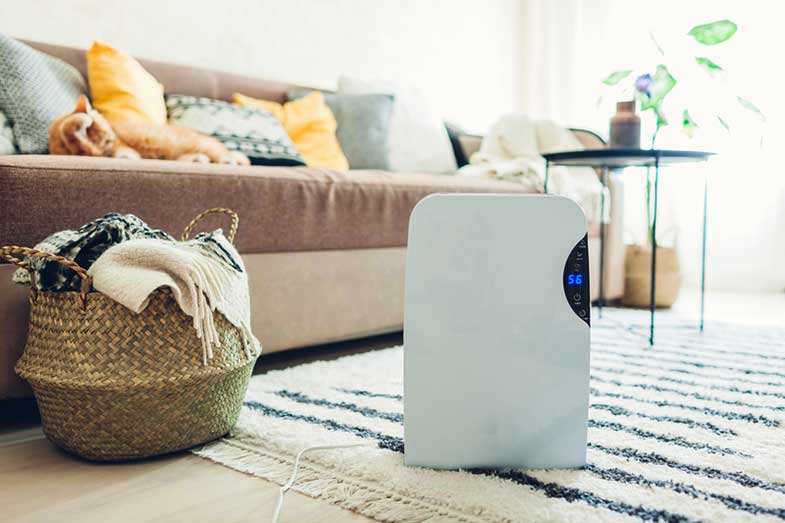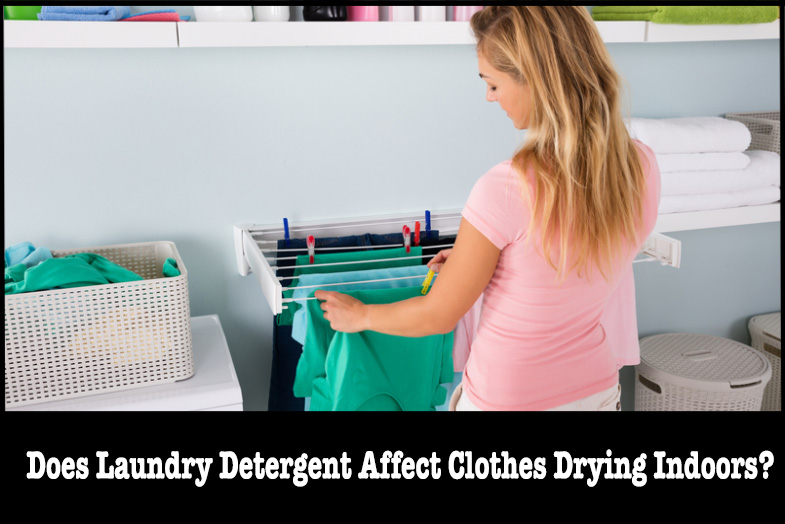Laundry detergent is not prepared as easily as it seems. There are lots of harmful synthetic chemicals in it that are slowly and steadily consuming your health. Detergent does affect our skin and causes many severe skin problems. In the same way, it affects the indoor drying process of clothes.
When we dry clothes indoors, the detergent does play its part in slowing down the process. Other than that, detergent affects the environment and clothes during this process. It also poses a health risk on the people living in that household.
The chemical formulation of detergent is actually very complex. They do more harm to us than good. This is why it is suggested to do every step of laundry carefully to protect all the family members.
Effect of Detergent on Clothes Drying Indoors

Some of us live in an apartment with little to no ventilation. Even balconies are missing in extremely small apartments. The other situation can be a humid and damp climate, which stops us from drying clothes outdoors. Such weather slows the drying time to such an extent that it takes forever to dry anything.
In such cases, the only solution to drying clothes seems the indoor drying. We go ahead with this without considering the effects it can have on our lives.
Read More: Laundry Detergent: Before or After Clothes?
Laundry Detergent Chemicals
We carry toxic chemicals with us everywhere that come to our clothes directly from laundry detergent. These chemicals make it difficult to dry clothes fast. These toxic chemicals stay in the clothes even after the wash cycle, making them difficult to dry.
An example of that harmful chemical is optical brighteners. Optical brighteners are added to make the white clothes appear brighter.
Little do we know that they are really toxic to our skins. Other than that, they do not decompose easily. As optical brighteners stay longer in the clothes, they allow the development of mold and mildew on clothes. These microorganisms grow in damp and wet places.
As these toxic chemicals stay on the clothes for a long time, the clothes take a lot of time to dry. The process becomes even slower during indoor drying because most of the time, there is no passage for air to cross the room.
Read More: Can Your Detergent Impact Your Acne and Skin?
Energy Consumption
Temperature is one of the factors on which the drying rate of clothes depends. When the temperature of the environment is higher, clothes dry quickly, as you might have observed that clothes dry quickly on a sunny day as compared to a cold winter day.
When you dry clothes indoors, you need something to speed up the process of drying. Usually, people keep a radiator in their laundry rooms. It heats up the room and thus helps in the process of drying.
However, this can be a bad idea as it consumes a lot of energy in the form of electricity. This energy is going waste for no reason.
To reduce energy consumption, you can hang clothes in the room where the fan is already running.
Health Risks

Indoor drying is really harmful due to the chemicals spreading in the environment.
We all are fully aware of the presence of surfactants and other harmful chemicals in laundry detergent. Commercial laundry detergents are prepared using synthetic chemicals. Synthetic chemicals are inevitably always harmful to our health. They do serve an important purpose when it comes to laundry but poses health risks to the environment.
Read More: Are Fabric Softeners Good for Asthma?
SLS (Surfactant)
SLS (Sodium Lauryl Sulfate) is a common surfactant used in laundry detergents. Research has found that it can be the reason for cancer. However, it is important to lower the surface tension of liquid for the easy suspension of dirt particles in water. However, continuous exposure to this chemical for a long time can cause mild to severe irritation in humans and animals.
A milder chemical than SLS, called SLES (Sodium Laureth Sulfate), is used as an alternative to prevent harmful effects. When you hang clothes to dry them indoors, these chemicals become a part of the environment. When that happens, the room where clothes are being dried becomes a prison containing carcinogenic chemicals.
If anyone stays in this room for a long time, he will likely carry these carcinogenic chemicals. When inhaled, they become a part of your body and start showing their deadly effects. These ingredients also cause several respiratory disorders like asthma.
This is the reason drying clothes indoors can not only be a slow process but also can affect your health.
Read More: What Makes Laundry Detergent Eco- Friendly?
Fabric Conditioners

Fabric conditioners are used in detergent to help the clothes become soft after they have been washed. Researchers have found that, directly or indirectly, fabric conditioners can increase the number of carcinogenic chemicals in the air.
Phenols
Phenols are another toxic chemicals added to detergents. Phenols are readily absorbed by our bodies and air. From clothes, these compounds get into the air and then inside our body. Even at low exposure, these compounds can be deadly.
Solution
Homemade and eco-friendly laundry detergents are the best alternatives to commercially prepared laundry detergents. They are made with safer and non-toxic chemicals. Homemade detergent can be prepared with totally natural ingredients to avoid any harm. However, homemade detergent is not as effective as commercially prepared ones.
Therefore, you can go for eco-friendly detergents to get the best results without risking your health.
Dust Mites and Mold Spores
People literally have no idea what they are contributing by drying laundry in their rooms. Some people even take washed clothes to their bedroom and decorate them everywhere just to get them dried. Little do they know that this leads to the development of mold spores and dust mites.
Since mold and mites love damp areas, they can grow in large amounts in such rooms where you dry laundry. These microorganisms can cause lung infections in people with very weak immunity.
You can reduce the growth of such organisms by drying laundry in well-ventilated rooms. Windows and doors carry moisture outdoors and make the room breathable. Also, make sure to regularly heat the place where your dry clothes to get these insects killed.
How to Fast Dry Cloth Indoors?

Drying clothes indoors can be risky as it raises the moisture level of your home. A lot of moisture attracts different microorganisms that love to stay in wet places. As these organisms grow on clothes and fabrics, there is a higher risk of you catching skin problems when you use those fabrics.
This situation calls for a solution to dry clothes faster. You can take several measurements to prevent the rising level of moisture and, at the same time, dry clothes faster.
Don’t Overload
This is by far the most important thing to keep in mind. We want to finish our work quickly by putting all the clothes at once in the dryer.
You will get damp clothes even after drying if you overload the dryer. This will prevent the clothes from drying quickly.
A safer approach is to add a small load and reduce the spin speed. This will prevent the laundry from getting over creased and, at the same, gets dried quickly.
Spread the Clothes Neatly
You don’t need to rush in this step. Take your time and spread each cloth neatly on the hanger. Since the surface area is directly proportional to the rate of evaporation, this step will work like magic.
Try hanging two clothes of the same size on a hanger in different ways. Do spread the first one neatly while rolling out the second piece of cloth. You will notice that the cloth that was evenly spread dried faster compared to the other one.
Get a Dehumidifier

You will never regret investing in a good dehumidifier. This appliance is an important thing to have in your laundry if you live in a region where the climate is always humid and damp.
A dehumidifier reduces the level of moisture from its environment in order to prevent the growth of mold and mildew. It can be kept anywhere in the house.
When you place a dehumidifier in a laundry room, you will see the drying process getting faster. The moisture produced by the dried clothes is trapped by this dehumidifier. As it captures the excessive moisture, the room doesn’t get damp. As a result, there is no risk of the development of microorganisms.
In Conclusion
Drying laundry indoors is in no way a good idea. Clothes contain water that evaporates into the environment, resulting in an increased level of humidity.
This humidity not only slows down the drying process but also becomes the cause for the development of several small insects like mites.
Also, the chemicals in the detergent stick to clothes; when water evaporates, some chemicals leave along with them and become the part of air that we breathe. These chemicals pose a threat to our lives.
Stay on the safer side and try to dry clothes outdoor. If you cannot do so due to the weather conditions, follow some preventive measurements to dry clothes faster and safer indoors.

